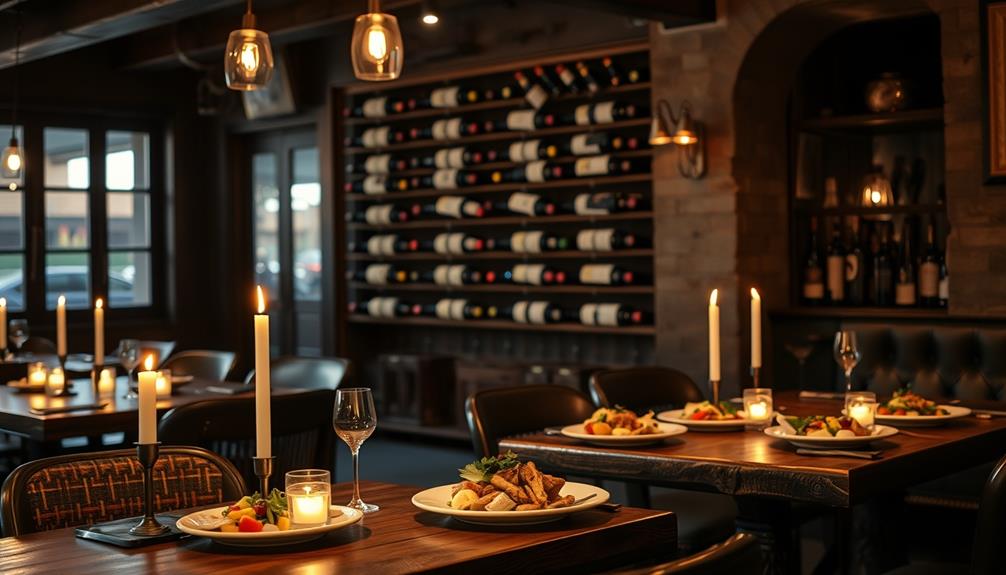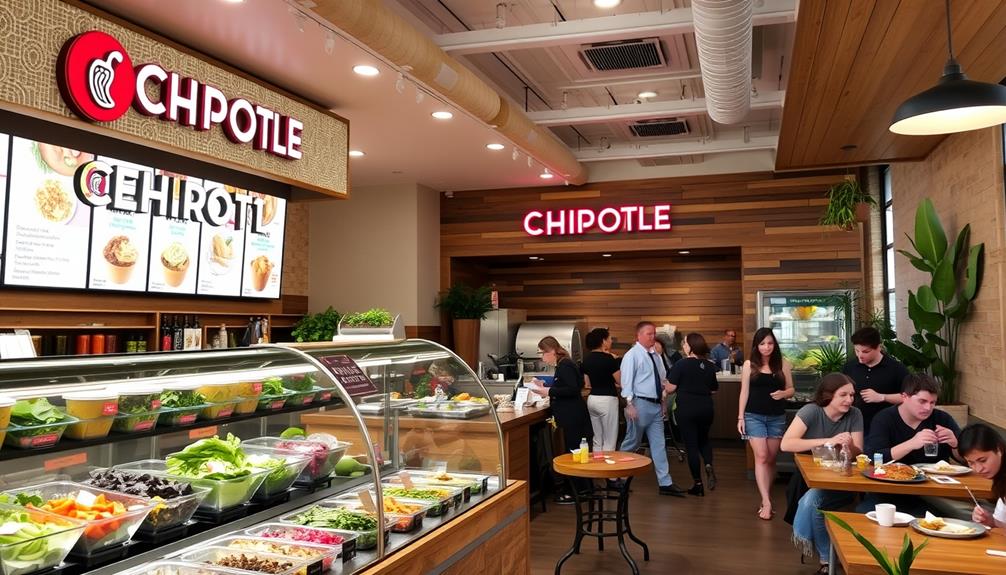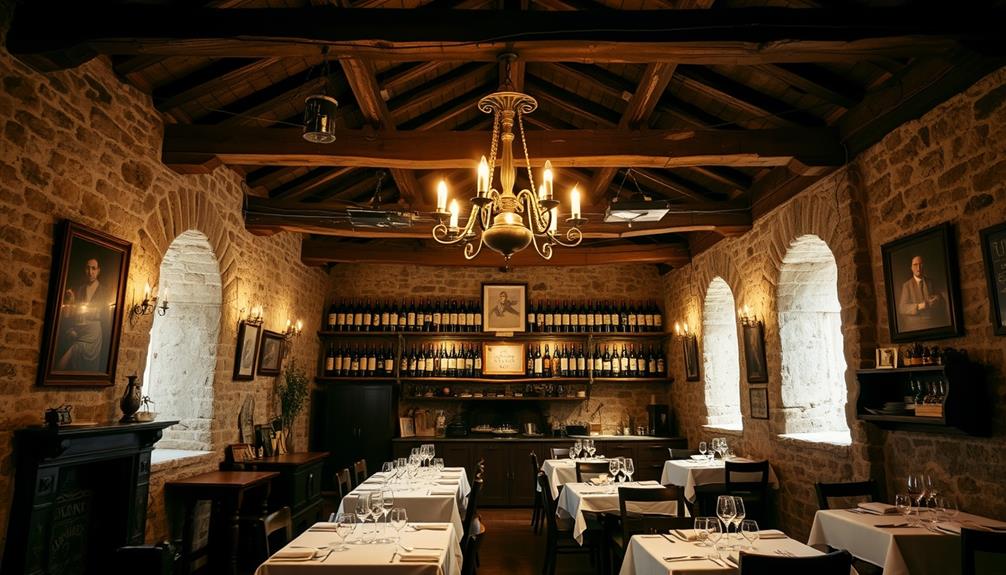When choosing a restaurant name, it's essential to capture attention and create lasting impressions. You want a name that resonates with your theme and cuisine, whether it's playful, elegant, or reflects local culture. Memorable names often use puns or unique spellings to enhance recall and attract customers. Think about what emotions or images you want to evoke. Engaging with feedback can also guide you in selecting the perfect name. Ultimately, the right choice can set your restaurant apart in a crowded market. Want to discover more tips and inspiration on naming your restaurant? Keep exploring!
Key Takeaways
- The restaurant name shapes first impressions and influences customer perceptions significantly.
- A memorable name enhances brand identity and drives customer loyalty in a competitive market.
- Unique names reflect the restaurant's theme and cuisine, fostering deeper connections with diners.
- Engaging with local culture and history can create storytelling elements in restaurant naming.
- Customer feedback plays a crucial role in shaping perceptions and informing branding decisions.
Importance of a Restaurant Name
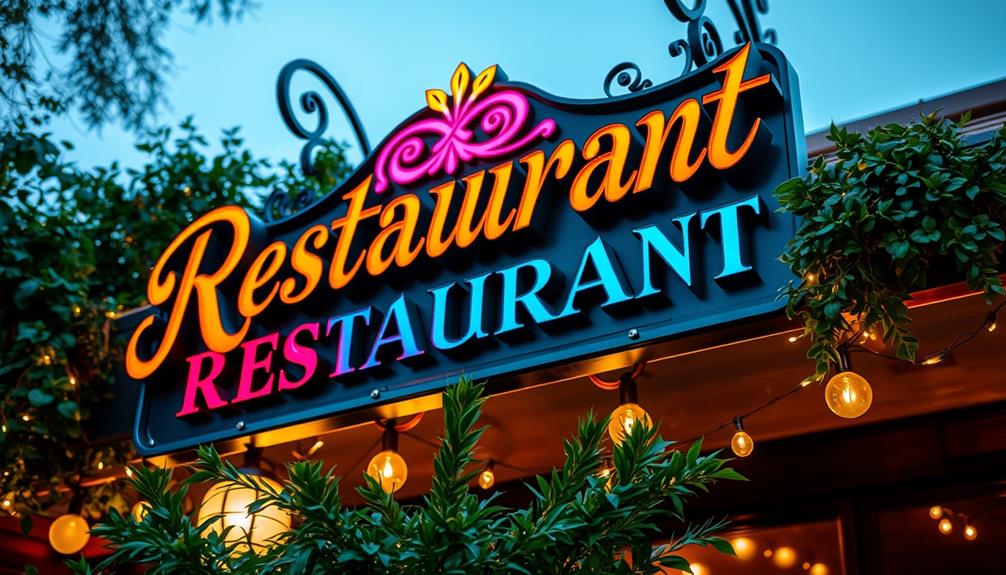
A restaurant's name plays an essential role in shaping customers' first impressions. It influences how they perceive your unique restaurant and sets the tone for their dining experience. A strong, unique restaurant name enhances your brand identity, helping you stand out among the over 1 million establishments in the U.S.
When people can easily remember your name, they're more likely to return, driving customer loyalty and repeat business. This process can be likened to the principles of design thinking where understanding user needs is fundamental for creating a memorable experience.
Effective naming doesn't just attract attention; it reflects your restaurant's theme and cuisine. A name that resonates with your mission and values fosters a deeper connection with your target audience, enhancing customer engagement.
When patrons feel a connection, they're more likely to share their experiences with others, further solidifying your restaurant branding.
In short, the importance of a restaurant name can't be overstated. It's your first opportunity to capture customers' interest and influence their expectations.
Invest time in choosing a name that truly embodies what your restaurant stands for, ensuring it leaves a lasting impression that turns first-time visitors into loyal patrons.
Creative Naming Strategies
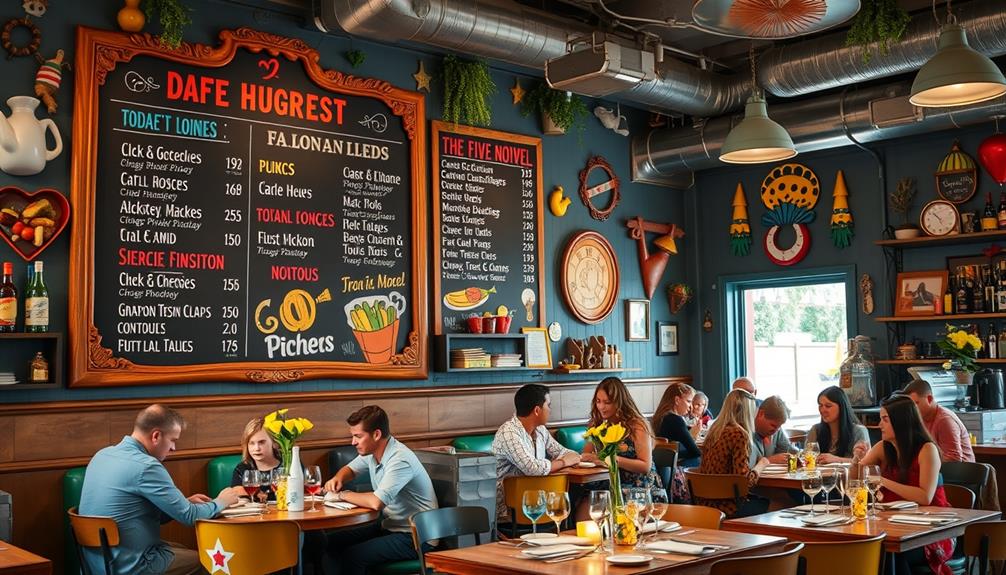
Choosing a memorable name is just the beginning; employing creative naming strategies takes your restaurant's identity to the next level. Immerse yourself in a pool of restaurant name ideas that spark your creative juices. Consider puns and wordplay—these not only add humor but also enhance customer recall. Names like "Vincent Van Doughnut" or "Unphogettable" grab attention and leave a lasting impression.
Additionally, think about how your restaurant's name can reflect a minimalistic approach to dining, similar to the way living in tiny homes encourages simplicity and intentionality. Don't shy away from unique spellings or symbols, like "&pizza," which create visual intrigue and set you apart from competitors.
Keep in mind that an original restaurant name is crucial; check for trademark availability using resources like TESS to avoid legal headaches down the road. Incorporate elements of local culture, personal stories, or regional descriptors into your name. This strategy connects with your target audience and enriches the dining experience.
Exploring Funny Restaurant Names

Humor plays an essential role in the restaurant naming game, creating an inviting atmosphere that draws customers in. Funny restaurant names like "Take It Cheesy" and "Kale Me Crazy" not only evoke smiles but also promise a lighthearted dining experience.
Puns, such as "Lord of the Fries," cleverly tap into popular culture, enhancing brand recall while attracting attention. Additionally, unique party options like themed dining experiences can enhance celebrations and contribute to a memorable atmosphere for diners unique party options.
Unique names like "Vincent Van Doughnut" merge artistic flair with culinary creativity, making your restaurant stand out in a crowded marketplace. These playful titles often target specific demographics, like "The Notorious P.I.G. BBQ," which resonates with rap culture enthusiasts. This strategy not only entertains but also fosters a sense of connection among potential diners.
The popularity of punny names reflects a broader trend in the restaurant industry where humor boosts customer engagement. When you choose a funny name, you're not just naming your restaurant; you're creating an experience that diners will remember and share.
Elegant Restaurant Name Ideas

While playful names can create a fun atmosphere, an elegant restaurant name sets the stage for a refined dining experience. Choosing a name that reflects an upscale atmosphere is essential for attracting discerning clientele.
Elegant restaurant names evoke luxury and sophistication, making a lasting impression. Additionally, considering the overall dining experience, such as the unique aroma in homes created by coffee, can inspire a name that resonates with guests.
Here are some ideas to inspire your choice:
- Elysium Bistro – A name suggesting paradise, ideal for a fine dining experience.
- The Gilded Fork – Conveys opulence and culinary excellence, enhancing brand recall.
- Celestial Feast – Evokes heavenly flavors and an elevated dining experience.
- Aroma of Elegance – Captures the essence of refined cuisine, appealing to your target audience.
Incorporating unique and sophisticated names not only differentiates your restaurant in a competitive market but also fosters customer loyalty. A well-thought-out name resonates with patrons seeking quality and refinement.
Family-Friendly Restaurant Names

Creating a family-friendly restaurant name can greatly impact your establishment's appeal to parents and children alike. When you choose family-friendly restaurant names, consider incorporating playful language that sparks joy and excitement. Names like "Kiddo's Kitchen" or "Tiny Tummies Café" immediately convey that your menu caters to younger diners, making parents feel at ease.
Additionally, incorporating elements that resonate with children's interests, such as themes found in best educational construction toys for toddlers, can enhance the overall dining experience. Think about how names evoking warmth, such as "Family Feast" or "Gather 'Round Grill," resonate with those seeking communal dining experiences. These names invite families to come together and enjoy meals in a cozy atmosphere.
Engaging themes can also help your restaurant stand out; for instance, names like "Dino Diner" or "Pirate's Platter" attract families looking for an adventurous dining experience.
Cultural Influences in Naming
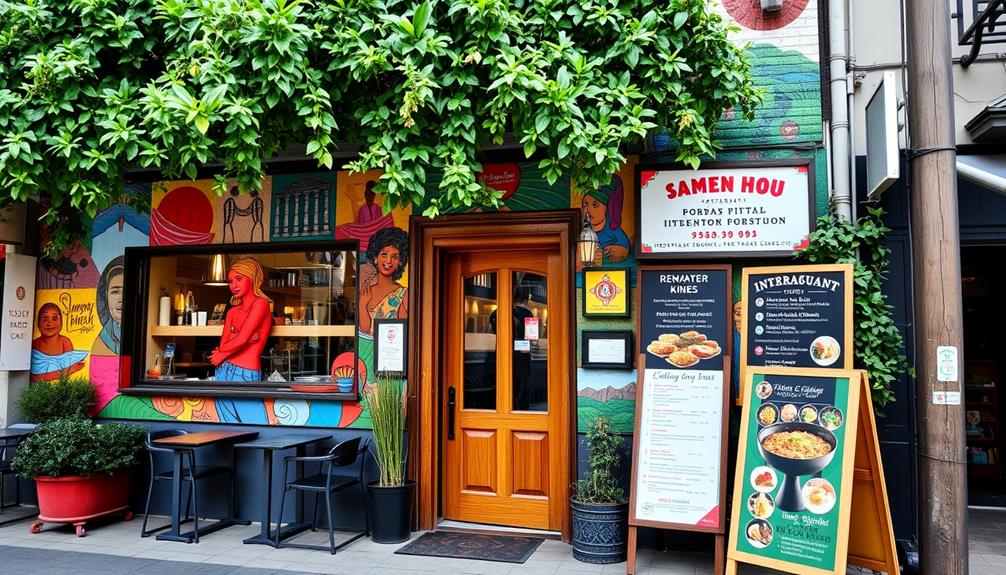
When you think about restaurant names, cultural influences often play a huge role in how they resonate with customers. Names that reflect regional cuisine or incorporate cultural symbols can create a connection that draws people in.
For instance, a restaurant that honors a mother's love through its name can evoke cherished memories, much like the heartfelt memories in tributes that celebrate love and legacy.
Whether it's a nod to local ingredients or a playful twist on popular culture, these elements add depth and identity to a restaurant's brand.
Regional Cuisine Reflections
Reflecting the rich tapestry of local culture, restaurant names often serve as a window into the regional cuisine they embody. They not only highlight local ingredients but also resonate with the community's cultural identity.
For instance, names that feature local specialties can evoke a sense of pride and belonging among diners, much like how hamster care and costs can reflect the commitment of pet owners to their furry companions.
When you explore these names, you'll notice a few key trends:
- Local Language: Many restaurants incorporate elements from the local dialect, enhancing their authenticity and relatability for diners.
- Descriptive Titles: Using regional descriptors like "Southern BBQ" or "Mediterranean Grill" clarifies the type of cuisine offered, attracting specific target customers.
- Cultural References: Names may evoke nostalgia or pride, creating a connection that deepens the dining experience for patrons.
- Unique Brand Identity: Successful establishments leverage these regional themes to stand out in a competitive market, fostering a distinct identity that resonates with local diners.
Cultural Symbolism in Names
Cultural symbolism in restaurant names plays a significant role in establishing connections with diners, as it often mirrors the cuisine's heritage and traditional practices. When you choose a restaurant name that reflects regional heritage, it enhances authenticity and resonates more deeply with customers seeking genuine dining experiences.
Moreover, incorporating local languages or cultural references can attract diners interested in diverse culinary traditions, fostering a sense of community. Here's a quick look at how different elements can shape restaurant names:
| Element | Impact on Restaurant Name |
|---|---|
| Local Language | Evokes regional authenticity |
| Historical Figures | Creates emotional connections |
| Myths or Legends | Adds intrigue and memorability |
| Culinary Traditions | Reflects the essence of the cuisine |
| Cultural Symbols | Attracts interest and curiosity |
Being aware of cultural nuances is essential to avoid misunderstandings or negative connotations. A carefully chosen restaurant name should align positively with your intended message and audience, ensuring it embodies the culinary traditions you offer. By doing this, you not only honor the culture but also invite diners into a rich culinary experience.
Tips for Unique Naming

When you're brainstorming a name for your restaurant, think about incorporating local flavor to make it resonate with the community. One way to incorporate local flavor is to use ingredients and dishes that are unique to the area. For example, if your restaurant is in New Orleans, you might consider incorporating Cajun or Creole influences into your menu. Additionally, consider using a name that reflects the history or culture of the community. For example, if your restaurant is located in a historic district, you could choose a name that celebrates the area’s heritage. When brainstorming, consider what sets your restaurant apart from the competition, whether it’s reheating prime rib at restaurants or offering a unique dining experience.
For instance, drawing inspiration from Southern traditions can create a warm and inviting atmosphere that attracts diners, similar to the charm seen in Paula Deen's Wedding Highlights.
Emphasizing unique themes can set you apart and attract curious diners, while ensuring easy pronunciation helps potential customers remember it.
Let's explore how these elements can come together to create a standout name for your establishment.
Incorporate Local Flavor
Incorporating local flavor into your restaurant's name can create a strong bond with the community while enhancing its memorability. A well-chosen name reflects the essence of local flavors, cultural references, and regional cuisine.
Here are some tips to help you craft a name that resonates:
- Use Local Landmarks: Incorporate well-known sites or symbols from the area to establish a community connection.
- Highlight Regional Ingredients: Feature specific local flavors or dishes to attract customers who appreciate regional cuisine.
- Engage with Local History: Tap into folklore or historical events that can add a storytelling element to your restaurant name.
- Collaborate with Local Artists: Involve local creatives in the naming process for culturally relevant and distinctive options.
Emphasize Unique Themes
Crafting a restaurant name that stands out requires an emphasis on unique themes that reflect your culinary vision. By incorporating unique themes, you not only create a memorable brand identity but also establish a strong connection with your community.
Consider how content relevance and authority can enhance your restaurant's visibility and appeal, helping potential patrons understand what you offer. Think about how cultural references or specific culinary styles can enhance your restaurant name, setting clear expectations for ambiance and cuisine.
Playful language, like puns or alliteration, can make your restaurant name more engaging, drawing in potential patrons. For instance, if your menu features Italian dishes, consider names that evoke Italy's charm.
Additionally, explore local history or landmarks for inspiration. Names tied to community heritage can foster a deeper connection with local clientele, allowing them to feel a part of your story.
Ensure Easy Pronunciation
Choosing a restaurant name that rolls off the tongue can greatly impact your brand's success. An easy pronunciation is vital for making your restaurant name memorable and accessible to everyone. To help you choose the right name, consider these tips:
- Use Common Phonetic Patterns: Opt for names that follow typical sound patterns, which guarantees ease of pronunciation for a wider audience. This approach is akin to creating a clear framework that guides customer interactions and perceptions.
- Avoid Complex Words: Steer clear of unusual spellings or complicated terms that might confuse potential customers and hinder recall.
- Test with a Diverse Group: Before finalizing your choice, share your name with a diverse group of people to check if they can pronounce it correctly.
- Incorporate Alliteration or Rhythm: Names that feature alliterative or rhythmic elements are often more memorable and easier to say.
Lastly, make certain your restaurant name aligns with your theme and cuisine. This clarity helps customers quickly recognize what you offer, enhancing their overall experience.
The Role of Customer Feedback
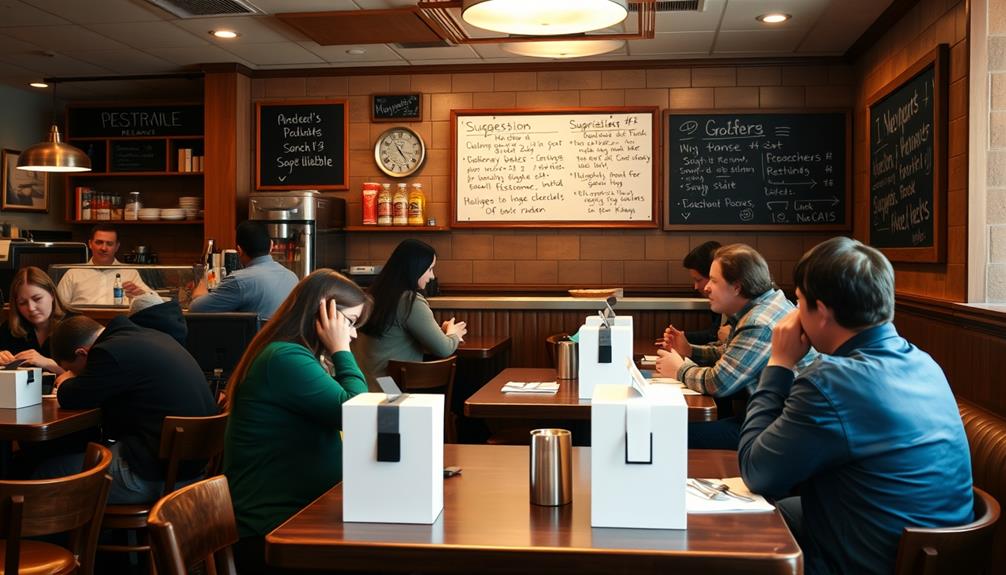
Customer feedback is essential for refining a restaurant's name, ensuring it truly resonates with your target audience. By gathering diverse perspectives through surveys and social media polls, you can uncover insights into how the restaurant name impacts customer perception and attraction. Engaging the local community in the naming process fosters a sense of ownership and enhances brand loyalty among potential customers.
Here's a table summarizing key aspects of customer feedback in the naming process:
| Aspect | Importance | Strategy |
|---|---|---|
| Customer Perception | Shapes how potential diners view your name | Conduct surveys |
| Brand Loyalty | Encourages repeat visits | Involve the community |
| Feedback Trends | Informs branding decisions | Analyze responses |
| Engagement Methods | Builds relationships with customers | Use polls and social media |
Examples of Memorable Names
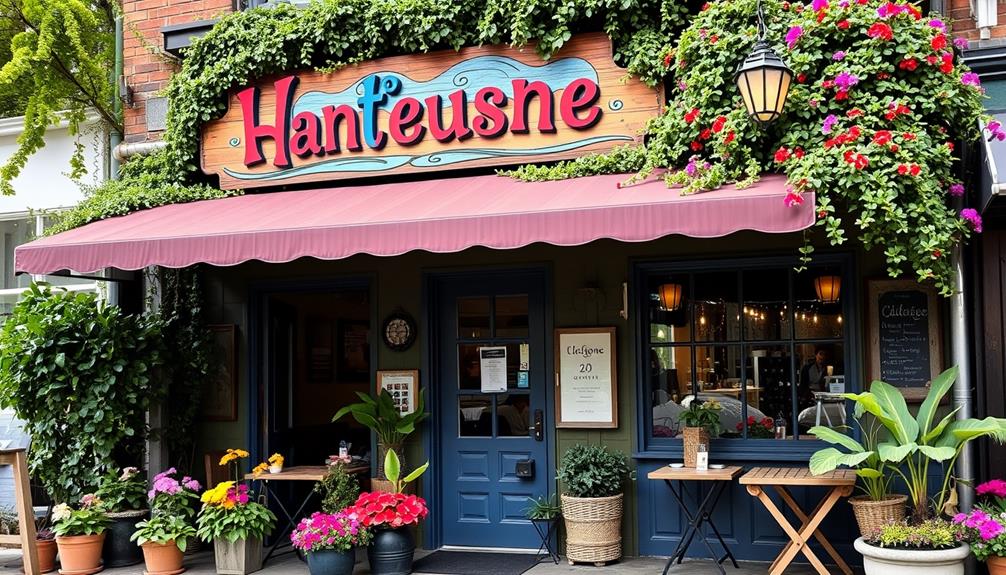
When it comes to memorable restaurant names, a clever twist can make all the difference. You want your name to stand out and invite curiosity. Here are some examples that illustrate key strategies for success:
- Puns and Wordplay: Names like "Vincent Van Doughnut" add humor and intrigue, making the experience enjoyable before customers even step through the door.
- Unique Spellings: Using symbols or unconventional spellings, such as "&pizza," not only catches the eye but also sets your restaurant apart from competitors, appealing to a modern audience.
- Short and Catchy Names: Opt for names that are easy to remember, like "Shake Shack." These names work well as URLs, enhancing your online presence.
- Successful Names: Names like "The Cheesecake Factory" clearly communicate what you offer. They're instantly recognizable and embody the restaurant's theme.
Lastly, always check name availability through trademark databases to verify originality and avoid legal issues.
Crafting memorable restaurant names requires creativity, but focusing on these elements can greatly improve your chances of success.
Frequently Asked Questions
How to Find a Restaurant Name?
To find a restaurant name, brainstorm ideas that reflect your mission and values. Research availability, get community feedback, and analyze successful names for inspiration. Aim for something memorable, relatable, and aligned with your brand identity.
What Is the Name of the Restaurant in the Chi?
You might've stumbled upon a delightful dining experience while exploring the Chi, where stunning views and exceptional service await you. Trust me, you won't forget the name once you've tasted the exquisite offerings.
What Are the Best Restaurant Names?
When considering the best restaurant names, think about uniqueness and memorability. Names that are descriptive, pun-filled, or thematic create a lasting impression, making it easier for customers to remember and choose your restaurant.
What Is the Name of the Restaurant in Office Space?
You might recall the restaurant in "Office Space" as a quirky place where characters express their frustrations with corporate life. It's known for its playful decor and embodies the struggles of everyday work culture.
Conclusion
Choosing the right name for your restaurant is like setting the stage for a delicious performance. It's your first chance to invite diners into your world, sparking curiosity and appetite. Whether you opt for something whimsical, elegant, or family-friendly, let your creativity shine. Picture your restaurant's name glowing like a neon sign, drawing in hungry customers from the street. Remember, a memorable name can be the secret ingredient that turns first-time visitors into loyal regulars.
